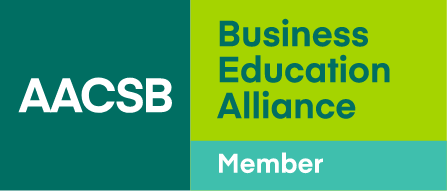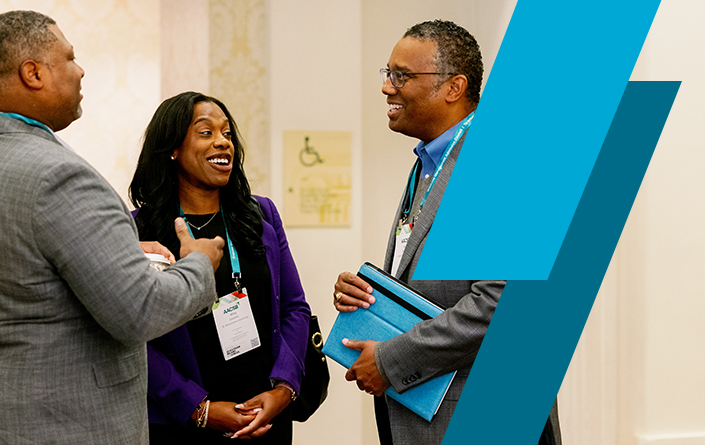Business Schools at a Turning Point
- AACSB’s 2025 State of Business Education Report highlights the challenges shaping business programs, from rising financial pressures to shifting student expectations.
- The report points to geopolitical disruptions and political uncertainty as trends that are affecting student mobility and forcing schools to rethink their recruitment, retention, and program delivery strategies.
- In response, deans believe that they must become more agile and adaptable, adopt entrepreneurial mindsets, and build strong leadership succession plans if they are to build future-ready institutions.
In 2025, it seems, business school deans require the skills of a strategist, a diplomat, and a master juggler. They must contend with the long-lasting effects of a pandemic and the explosion of artificial intelligence (AI). They must make critical investments in infrastructure while coping with reductions in public funding. All the while, they’re grappling with the impact that demographic shifts and tense geopolitical relations have on the makeup and expectations of their student populations.
Earlier this year, AACSB released its 2025 State of Business Education Report, which offers more insight into the forces affecting the industry, so academic leaders can better prepare for an uncertain future. The report’s conclusions are based on data from the association’s Business School Questionnaire, 14 regional roundtables, and survey responses from 890 participants at 800 institutions worldwide.
Now, as deans in many regions prepare to begin a new academic year, how are they positioning their schools for 2026 and beyond? Below, we revisit three of the report’s core themes: financial resilience, shifts in learner expectations, and evolving leadership demands. In addition, six deans across five countries put these themes into their regional contexts and share the steps they are taking to future-proof their institutions.
Theme 1: Building Financial Resilience
According to the report, the average operating budget for AACSB-accredited schools has increased by 19 percent between 2018–19 and 2023–24 (to 39.6 million USD). However, average expenditures have increased by 21 percent. Many of these expenditures likely stem from greater investments in critical areas such as technology and infrastructure.
It’s no wonder that 76 percent of the academic leaders that AACSB surveyed agree that their schools must adopt new financial models and strategies if they are to maintain future viability.
Among those leaders is Jennifer Chatman, dean of Haas School of Business at the University of California, Berkeley. At Berkeley Haas, growth initiatives are focused on three main areas. First, the school is expanding its flexible educational options. This includes its Flex MBA program, which allows students “to shape their own MBA experience on their own terms,” says Chatman.
Second, the school is establishing new offerings in four high-demand areas: sustainability, entrepreneurship, healthcare, and AI. These include an MBA/Master of Climate Solutions joint degree, launched in fall 2024, as well as an AI certificate and AI concentration for full-time MBA students.
Finally, the school wants to expand its executive education offerings, says Chatman, with the goal of “doubling annual revenue from 40 million USD to 80 million USD in five years.”
The operating costs for EGADE Business School at Tecnológico de Monterrey in Mexico are being affected by a complex set of factors, says its dean, Horacio Arredondo. These include tuition sensitivity, inflationary pressures, increased competition from alternative education providers, a lack of public funding sources, and limited philanthropic support.
EGADE is diversifying its revenue base with offerings such as customized corporate programs, specialized master’s degrees, and lifelong learning options tailored to regional needs.
In response, EGADE is diversifying its revenue base with offerings such as executive education, customized corporate programs, specialized master’s degrees, and lifelong learning options tailored to regional needs. In addition, the school is working to attract new donors, deepen alumni engagement, and create new pathways for impact investing.
Arredondo also views digital and AI-based learning platforms as the means to reduce costs, expand access, and enhance the student experience without sacrificing program quality.
Theme 2: Reaching New Types of Learners
Business schools must keep up with the growing demand for flexible learning formats among Gen Z, mid-career, and late-career individuals. Nontraditional learners increasingly prefer shorter, more targeted offerings, such as microcredentials and stackable certificate programs.
Simultaneously, the pool of prospective students is being impacted by falling birth rates and a range of factors affecting international student mobility. The report points out that “evolving visa regulations, international student caps, geopolitical tensions, and economic uncertainties have significantly influenced where and how students choose to pursue their education.”
“International students are spooked by government policy changes in countries around the world,” says Jenny George, dean of Melbourne Business School. “We are seeing them apply to more programs but be pickier about which they commit to.”
Simultaneously, Melbourne Business School is seeing its online enrollments increase as domestic part-time students demand more flexibility. In response, the school launched an online MBA in 2023 and is experimenting with different delivery formats for its residential part-time programs.
Berkeley Haas is also navigating “changing federal policies affecting student visa issuance,” says Chatman. For instance, the school quickly established a task force to develop a contingency plan for MBA students who were unable to secure visas to the U.S. before the coming fall semester.
Berkeley Haas recently created a comprehensive learning solution for MBA students who were unable to secure visas to the U.S. before the coming fall semester.
For those students, she explained, “we created a comprehensive online learning solution that both complies with visa regulations and ensures uninterrupted program participation.”
At Georgia State University’s Robinson College of Business in Atlanta, more than half of the students are now Gen Z, says Richard Phillips, the school’s dean. Because these students demand greater flexibility, personalization, and career alignment, Robinson has expanded its online offerings and introduced synchronous and asynchronous formats for its MBA.
The school’s international enrollments are also in flux. Traditionally, international students have made up one-third of the school’s student body, but Phillips anticipates “a significant shift in this proportion” due to recent immigration policy changes and the evolving political climate. To offset this shift, the school plans to expand its outreach to countries where it has seen recent growth, such as Vietnam, South Korea, and Bangladesh.
Longer-term, Phillips is preparing for a different challenge: a shrinking pipeline of traditional graduate students. “High school graduation rates here are plateauing, which is increasing competition in our market,” he says. He predicts that a decline in birth rates that began in 2008 promises to depress the school’s enrollments in the 2030s.
To prepare for this potential outcome, the school is expanding offerings to accommodate “increased demand for mid-career upskilling and reskilling due to the rapid growth of AI technologies,” Phillips explains. It has created new AI-focused certificates, concentrations, and graduate courses. During the 2025–26 academic year, it also will launch new degree programs that integrate AI with business, accounting, and actuarial science.
Theme 3: Building New Leadership Skills
For AACSB deans, seven leadership challenges loom largest: faculty management and development, student enrollment and retention, financial management and resource allocation, time management, institutional management, faculty recruitment, and change management.
Given this daunting list of responsibilities, it’s perhaps not surprising that the average tenure of deans has shortened—to 6.2 years in 2023–24, down from 6.8 years in 2020–21. For deans to thrive in their positions, the report stresses, they will need to develop a new set of skills.
For Chatman of Berkeley Haas, leading effectively amid disruption requires a commitment to her school’s core values: Questioning the Status Quo, Confidence Without Attitude, Students Always, and Beyond Yourself. “Our core values serve as our competitive advantage, enabling us to pivot and adapt to any challenge.”
Technological proficiency is another critical skill, says Julian Birkinshaw, dean of the Ivey School of Business at Western University in London, Ontario, Canada. “We have to become more fluent and savvier around digital technology and learn to harness it to help our students and also ourselves.”
Academic leaders also must be agile, he says, so they can be quick to identify and act on emerging opportunities. He adds that, in response to the world’s volatile political environment, leaders at Ivey are striving “to develop a more international outlook on how we operate and where we look for opportunities.”
Staff and faculty members at Ivey Business School can enroll in the school’s executive MBA or shorter executive programs to develop their leadership skills.
Jörg Rocholl, president of ESMT Berlin, believes that today’s academic leaders need to develop courage to drive transformation, foresight to anticipate change, and resilience to navigate uncertainty. They also need to embrace entrepreneurial thinking and devise strategies that respond to evolving societal expectations involving sustainability, societal impact, and ethical action.
“Today’s leaders must be able to balance profitability with purpose, integrating environmental and social considerations into their strategies,” he emphasizes.
To ensure the long-term prospects of their institutions, these administrators have made robust leadership succession planning a top priority. “Leadership success,” says Rocholl, “is supported by creating a strong pipeline of internal talent, mentoring future leaders, and fostering a culture of continuous development and empowerment.”
With the same goal in mind, Ivey has “ongoing programs to support managers and faculty, some of them run by our HR team,” Birkinshaw notes. Some staff and faculty members enroll in the school’s executive MBA or shorter executive programs to develop their leadership skills and their AI literacy.
Because Melbourne Business School is financially and operationally separate from the larger university, “transferring talent in from outside doesn’t always work,” George explains. For that reason, she meets with faculty, including new hires, to identify individuals who are interested in assuming leadership roles. She then creates formal development plans for those most likely to take on leadership roles in the next 20 years.
Partnering for Shared Progress
Ultimately, these deans agree: No institution can achieve its goals alone. To use their resources to greatest advantage, schools will need to form strong partnerships—with other schools, with industry, and with networks such as AACSB.
Robinson College, for example, is “co-developing new analytical methods and tools alongside our business partners,” says Phillips. “This collaborative approach will produce next-generation business leaders who have already demonstrated their capacity to positively impact their lives, families, communities, and global society.”
Global networks such as AACSB, Arredondo stresses, have the resources to catalyze collaboration, facilitate diverse partnerships and benchmarking, deliver region-specific professional development, and help member schools scale best practices. Likewise, he adds, “forging deeper partnerships with key industries, developing co-funded research, and exploring innovative financial structures such as income agreements can transform how we resource our education mission.”
Birkinshaw believes that AACSB also can provide “a useful forum to discuss our challenges and to form a united view when lobbying government.”
Alliances and partnerships will be “crucial for encouraging shared progress, promoting innovation, and ensuring that business education remains a force for good.”—Jörg Rocholl, ESMT Berlin
ESMT further broadens its global reach through participation in the Global Network for Advanced Management (GNAM) and the Future of Management Education (FOME) alliance, Rocholl says. The school also supports its recruitment efforts through a collaboration with Mannheim Business School and WHU–Otto Beisheim School of Management. Together, the partners are running their Come to Germany campaign, which promotes Germany as a “destination for those seeking not just a degree, but a community committed to open inquiry and impact.”
For Rocholl, networks such as GNAM, FOME, and AACSB, as well as a deep well of partnerships, will be “crucial for encouraging shared progress, promoting innovation, and ensuring that business education remains a force for good in every corner of the world.”
Reimagining Business Education
What do these deans hope to see happen in 2025 and beyond? Birkinshaw of Ivey is “optimistic that the macro conditions, internationally and within Canada, will turn a corner by the end of 2025. It’s been a tough few years for business school graduates in terms of finding good jobs, and the budget cuts don’t help us.”
By the end of 2025, Rocholl wants “to see business schools continue to shape responsible leaders who drive economic success while contributing to social progress and environmental sustainability.” George hopes that schools in Australia will become “more connected to our business community and for there to be more two-way dialogue and applied research taking place.”
“AI fluency will be essential,” says Chatman, who stresses the need for business schools to maximize AI’s potential to support their strategic goals. At Berkeley Haas, a task force is examining how staff are already using AI and is developing recommendations for increasing efficiency throughout the school.
Phillips plans “to create working groups within the college focused on rethinking how we operate more efficiently and effectively,” while Arredondo hopes that “Latin America can be recognized for a distinctive model of business education that is globally competitive yet deeply attuned to local realities and contexts.”
As the future of business schools continues to unfold, and as new challenges arise, the skills that academic leaders require are sure to become even more nuanced and multifaceted. But the aspirations and insights shared above suggest that business education is not simply evolving—it is being redefined. The schools that succeed won’t be those that resist disruption but those that embrace it, as they work across sectors and borders to transform uncertainty into opportunity.






